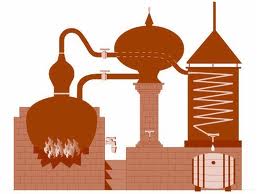David on Technical Topics – Cognac Distillation, The Still

The cognac distillation process is the most technical part of making the golden nectar. It is the stage where the wine is reduced to a spirit, which we refer to as ‘eau de vie’. Distillation is carried out twice. The first time it changes the wine to a ‘brouillis’, a cloudy liquid with a strength of around 27 – 30% alcohol, and then it is distilled again. In this article we will consider the distillation equipment required and next month we will explore the process.
The complete distillation process is controlled by the Bureau National Interprofessionel du Cognac (BNIC) and every distiller must comply with the rules that protect the name of ‘Cognac’. The process usually starts at the end of October once the grapes have fermented and changed into a relatively low alcohol, acidic wine.
The bulbous, onion shaped, original design of the cognac still is largely accredited to the Dutch in the seventeenth century and has not changed significantly since. Sitting on top of this still is the chapiteau or still head. This is where the vapour rises after boiling and before continuing into the swan’s neck, an appropriately named pipe extending from the top of the still head. Eventually the vapour enters the serpentin, a large coil in a water tank, where it condenses before entering a tank ready for the second distillation.
Different still designs can influence the cognac’s final flavour. Firstly the size of the still is important. The smaller the still the more distinctive the cognac it produces whereas larger stills tend to provide more neutral flavours. The problem of neutrality is also created by the shape of the still head. Large, wide onion shaped stills allow the vapour to drip back into the still, a process known as rectification, and so the spirit is re-distilled. Conversely, narrow, shallot shaped heads allow the vapour to leave the still faster, with less risk of it condensing, before it has rounded the swan’s neck.
The other choice distillers must make is whether or not to use a chauffe-vin , a type of heat exchanger which sits between the still and the serpentin (condenser). This enables the warmth of the hot vapour to warm the wine before it enters the still for boiling whilst the initial temperature of the wine cools the vapours to initiate condensation.
Next month I will look at the Distillation Process. To read more Technical Topics, go to our Brandy Education page.
